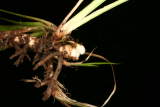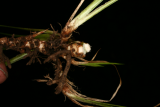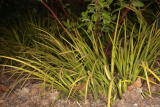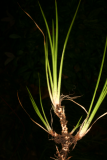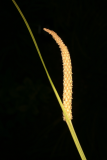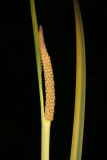Additional notes (click to expand)
Medicinal
The following notes apply to the species of this plant:
Acorus gramineus Aiton, Acoraceae. Japanese sweet flag; grassy-leaved sweet flag. Rhizomatous perennial. Distribution: E. Himalaya to Japan and Philippines. The cultivar 'Oborozuki' has yellow leaves with green stripes. The rhizomes are aromatic. The European Acorus calumus is used to make a volatile oil which contains β-asarone as the major component. This is carcinogenic in animal studies and nephrotoxic and epileptogenic. Acorus gramineus is used medicinally throughout Asia and In the Philippines it has the same multiplicity of uses as A. calamus, including treatment of arthritis, lumbago, muscle pains, indigestion; toothache, as a tonic, to increase the appetite, haemorrhage, treat intestinal ulceration, used as a sedative, for tinnitus, deafness, poor memory, unconsciousness during a fever, for treating insanity, as an insecticide abscesses and scabies and to protect young children from getting flatus when someone compliments them on their appearance – a condition known as ‘usog’.
Oakeley, Dr. Henry F. (2013). Wellcome Library notes.
link
Other use
Extract of the rhizome showed insecticidal activity when sprayed on the painted bug Bagrada cruciferarum
Gupta, A.K.. (2004). Indian Medicinal Plants. Volume 1 (Abe-Alle. Indian Council of Medical Research, New Delhi. P.211
Acorus gramineus Aiton, Acoraceae. Japanese sweet flag; grassy-leaved sweet flag. Rhizomatous perennial. Distribution: E. Himalaya to Japan and Philippines. The cultivar 'Oborozuki' has yellow leaves with green stripes. The rhizomes are aromatic. The European Acorus calumus is used to make a volatile oil which contains β-asarone as the major component. This is carcinogenic in animal studies and nephrotoxic and epileptogenic. Acorus gramineus is used medicinally throughout Asia and In the Philippines it has the same multiplicity of uses as A. calamus, including treatment of arthritis, lumbago, muscle pains, indigestion; toothache, as a tonic, to increase the appetite, haemorrhage, treat intestinal ulceration, used as a sedative, for tinnitus, deafness, poor memory, unconsciousness during a fever, for treating insanity, as an insecticide abscesses and scabies and to protect young children from getting flatus when someone compliments them on their appearance – a condition known as ‘usog’.
Oakeley, Dr. Henry F. (2013). Wellcome Library notes.
link
Geographical distribution
- Asia-Temperate, Eastern Asia, Japan
- Asia-Temperate, Eastern Asia, Korea
- Asia-Temperate, Eastern Asia, Taiwan
- Asia-Tropical, Indian Subcontinent, India
- Asia-Tropical, Indo-China, Myanmar
- Asia-Tropical, Malesia, Philippines
Acorus gramineus Sol. ex Aiton 'Oborozuki'
Family: ACORACEAEGenus: Acorus
Species: gramineus Sol. ex Aiton
Cultivar: 'Oborozuki'
Common names: Grass-Leaf Sweet Flag
Distribution summary: Temperate & Tropical Asia
Habit: Perennial
Hardiness: H5 - Hardy; cold winter
Garden status: Currently grown
Garden location: Plants of the World (C)
Reason for growing: Medicinal
